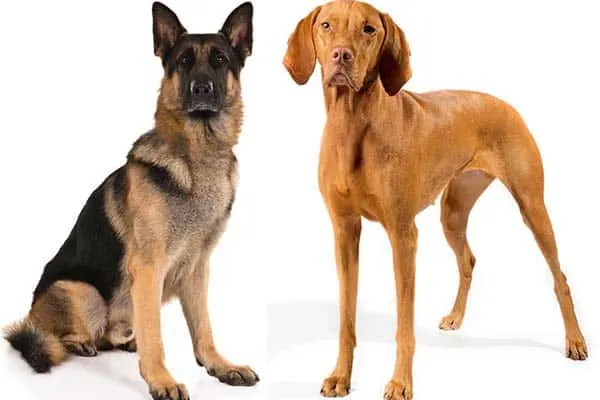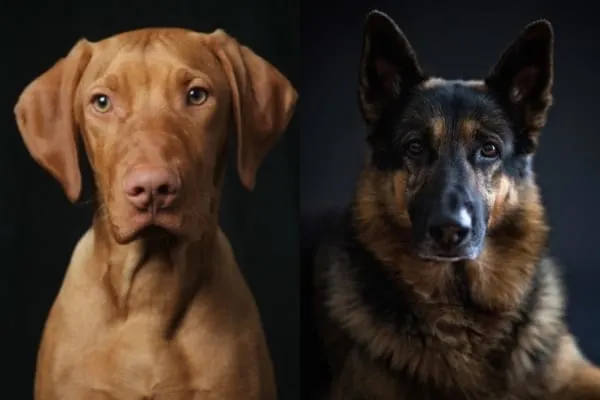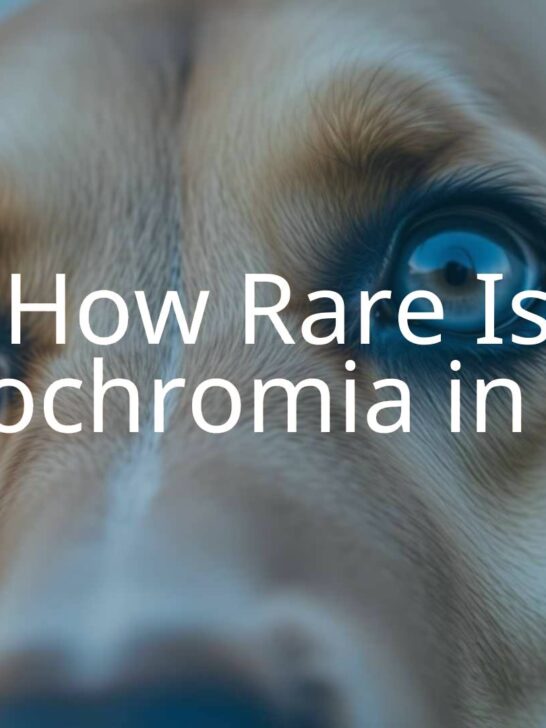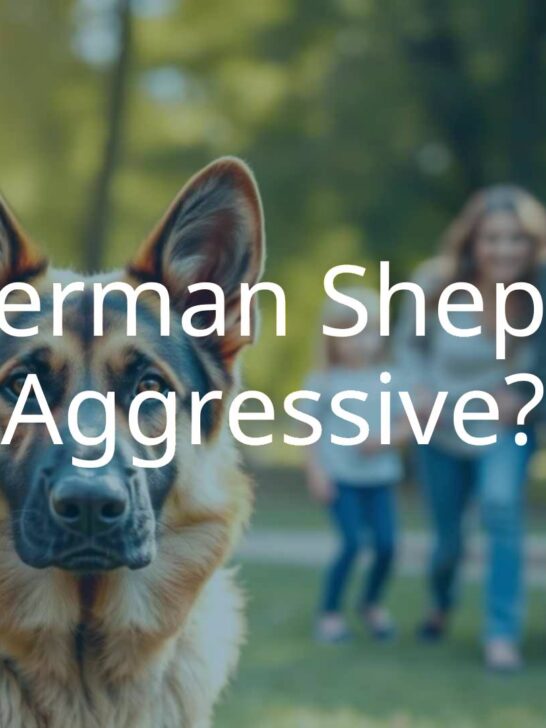The Vizsla German Shepherd Mix: Steady and Ready to Work
Since the 1990s, the trend of crossbreeding two great dog types has been a popular one. Many breeders did this in order to promote the best in two different breeds, such as the Goldendoodle, a hybrid breed that was developed in order to promote the hypoallergenic properties of the Poodle while boosting the intelligence that is already in place in both breeds.
According to dog-learn, One mix that hasn’t garnered a great deal of attention but is still a worthy hybrid development is the German Shepherd and Vizsla mix.
The Vizsla German Shepherd Mix is one that is definitely a mixture of the best of both breeds. The German Shepherd is a great family dog, as is the Vizsla. They are both working dogs, and they both have a great deal of energy.
However, the similarities tend to dissipate from there. These two breeds have many great qualities, that, when combined, make for a sociable, friendly, hard-working pup!

The German Shepherd
According to AKC, The German Shepherd was the development project of one Captain Max von Stephanitz, who deeply considered the herding dogs of his native Germany to be of the finest caliber of dogs, sought to bring about one superior breed out of all the many at the time.
In the late 1890s, von Stephanitz traveled to Britain where he began observing the breeding practices of native Brits.
While at a dog show in England, von Stephanitz observed a dog that he felt not only had the beauty and brawn of the herding dogs of Germany, but also the intelligence he felt this superior breed of canine should possess. Von Stephanitz purchased the dog, and he returned back to Germany to begin a breeding program.
Von Stephanitz’s purchase was originally named Hektor Kinksrhein. The Captain noted that he favored the wolfish dogs that were currently in use in Germany by shepherds, as well as possessing the athleticism and capabilities that these dogs also exhibited.
He would rename Hektor Horand v Grafeth, and he invited farmers from all over Germany to bring the very best of their dogs to breed with Horand. Von Stephanitz would eventually create a breeding society known as the Verein fur Deutsche Schaferhunde that was purposed to follow Horand’s Descendents.
Again, von Stephanitz began this breeding program in 1898. Unfortunately, at this time in most of Europe, industrialization was the latest trend, and dogs used on farms became fewer and fewer.
However, von Stephanitz began to see that there was a place for his dogs in military and police work, as well as in other areas of service.
During World War I, the dog that would become known as the German Shepherd worked as a Red Cross rescue dog, a messenger, guard, and supply carrier for the German military. He would do so again in World War II.
In fact, the presence of the German Shepherd as a military dog is what helped to popularize the GSD (German Shepherd Dog) in Americans’ eyes as well.
Many Allied servicemen noted the tenacity and intelligence of the German’s military dog, and one American soldier would happen upon a five-day-old puppy in a bomb-out city in France.
The soldier would bring that young pup back to America with him, and that dog would go on to become one of the most recognized German Shepherds in Hollywood – Rin Tin Tin.
The German Shepherd is a family dog, but his primary purpose is that of being a working dog. This highly intelligent dog is one that craves a job, and, when owners or handlers begin training at just a few months of age, the German Shepherd will grow up knowing he has a purpose that is worthwhile.
The GSD today is often employed as a military or police dog, as previously mentioned, but they are also terrific service dogs, working with the blind or doing rescue work.

The Vizsla
While the German Shepherd is a dog that was only developed as a breed unto its own in the last 150 years, the Vizsla is one that has been around for over 1,000 years.
According to AKC, Once known as the Hungarian Pointer, the Vizsla is likely descended from the hunting dogs that populated Hungary when the Magyars settled the area a millennia ago.
The dog is a natural pointing and retrieving dog, as demonstrated by the noblemen who used the Vizsla to flush out and then retrieve game birds and other small game. Over time, Vizsla enthusiasts would work to further develop the natural talents of the breed.
The Vizsla has appeared in numerous paintings and other pieces of artwork that depict the breed accompanying hunters; the dog is also mentioned in a work of literature that describes the breed as assisting its handler in falconry.
Both of these pieces of art date back as far as the tenth century. In other words, the Vizsla has been around for a very long time!
Like the German Shepherd, the Vizsla was a service dog utilized during World War I. Because of the Vizsla’s superior scenting abilities, he was highly sought out on the battlefield and as a rescue dog.
According to AnimalPlanet, He also worked as a messenger during this time period. During the 1950s, many Vizslas were exported to the United States, where individuals saw the same potential that their European neighbors had realized for centuries.
The Vizsla is not only a hunting companion, but he is also a service dog in the United States. In fact, Vizslas were present in the rescue missions following the World Trade Center attacks.

While the German Shepherd is a breed that is sometimes aloof and reserved, the Vizsla is more of a sociable dog. They tend to be better with children than the German Shepherd (NOTE: ANY breed of dog is typically good with children and families when socialized from a younger age).
They are also more adaptable with an inexperienced owner; the German Shepherd does best when he has an owner who is knowledgeable about the breed and who is able to provide the activity that the GSD needs.
Although they have a few personality differences, the GSD and the Vizsla are both considered exceptional dog breeds. They are both intelligent, and they crave a job at which to work. Both are fairly trainable as well.
However, one area in which the two breeds are distinctly different is in their grooming needs. The Vizsla is typically a dog that needs very little in the way of brushing and other care, but the German Shepherd has a coat that requires more work.
The German Shepherd will sport a medium-length double coat of fur that is both water-resistant and able to repel a good bit of dirt. However, this double coat has its drawbacks.
The outer coat typically lies fairly close to the body, but the German Shepherd is most definitely a “shedder,” meaning that you can expect to see a great deal of hair on surfaces where the GSD spends a good bit of time.
In addition, the German Shepherd will “blow” his coat at least twice a year. Blowing the coat means that a great deal of hair will be shed, all at once.
Some observers compare this to a “snowstorm,” thus the term “blowing” the coat. Because of the amount of shedding the GSD is prone to experience, he is not considered hypoallergenic; however, neither is the Vizsla.
There are many other similarities between the German Shepherd and the Vizsla. Both breeds are roughly the same height; the Vizsla is only slightly smaller than the GSD (typically by only one inch in height at the shoulders).
The German Shepherd is a heavier dog than the Vizsla; the GSD outweighs the Vizsla by about thirty pounds. Both are extremely intelligent, highly trainable, and full of energy.
The German Shepherd and Vizsla mixed breed dog will definitely need an owner who is willing to provide the hybrid dog with plenty of activity; otherwise, you may have an unhappy pup who is prone to barking, howling, chewing, and digging.
The German Shepherd has the potential to be a very friendly dog, but the Vizsla is much more sociable. The GSD tends to be rather standoffish; a hybrid breed is likely to be a great combination of the two personalities.
The German Shepherd is considered to be “kid-friendly,” but the best results take place when the GSD is socialized (given ample exposure to) children from a fairly young age. On the other hand, the Vizsla is naturally affectionate toward children regardless of any exposure to kids.
The GSD is also considered to be tolerant of other pets, including cats. The Vizsla, by contrast, is naturally pet-friendly, regardless of any socialization with other animals.
One area where the two breeds are definitively different is their “stranger-friendly” status. As previously suggested, the GSD does not do well with people unfamiliar with them.
The Vizsla rarely meets a stranger, and, when they do, the dog is typically very receptive to new people. However, when purchasing a hybrid dog of the GSD and the Vizsla, early socialization will aid in making sure that the designer dog is people-friendly.




















